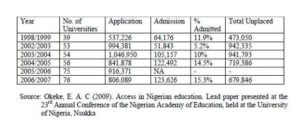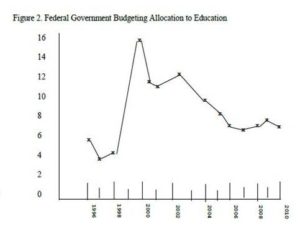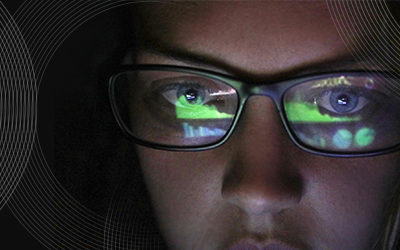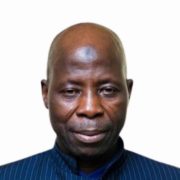Open education
How web technology can bring university education to millions of Nigerians
Hope for many to realise the dream of an advanced degree rests on online education writes SEGUN ORUAME
Consider these facts: Over 1.5 million candidates sat for the Unified Tertiary Matriculation Examinations in 2012 to gain admission into about 292 tertiary institutions in Nigeria. Only 500,000 admission slots were available. As of 2010, there were 27 federal universities, 31 state universities, 34 private universities and over 200 polytechnics and other colleges. Every year, the scramble for the limited spaces in the existing universities in Nigeria records a steady increase against the ability of the tertiary institutions to meet the rising demand. See Table on the demand and supply of university education in Nigeria indicating trends from 1998 to 2007.
Demand and Supply of University Education in Nigeria 2000 – 2007
The eTechlligence findings indicates trend of a steady 25% to 42% increase. From 2008 to 2012, for instance, in 2012, 1.5 million applied for tertiary admissions; over a 40% increase. In 2013, the figure is in excess of 1.5milllion and the available spaces are just a little above 500, 000. eTechlligence is the market intelligence arm of Knowhow Media International, publishers of eT Edge News. Only a paltry 18 out of every 100 applicants gain admission into the limited number of tertiary institutions in Nigeria making it one of most limited areas in the world to seek for advanced educational opportunities. But compared to several other African countries in terms of allocation of resources and size of population, Nigeria presents a much encouraging picture which paints the overall frightening picture of denied-opportunities across the continent which technology can help to close. ‘Open and Distance Learning is a globally recognized as veritable answer to the huge demand for tertiary education in countries of shrinking spaces in the traditional campus based schooling.’ More than anything else, online distance learning offers the opportunity to return to school, gain the much coveted degree without having to leave the workplace. The technology-driven ‘school-place’ seeks to improve the knowledge base of the gainfully employed and expose them to enhanced skill-sets to advance their career without having to seek for leave of absence.
Enrolment in Nigerian Universities 1960 – 2008
With over one million potential candidates failing to gain admission into tertiary institutions in Nigeria owing to lack of space, a consequent of poor educational funding, there is little hope that campus-based tertiary education could address the shrinking opportunity to acquire advanced degrees. Nigeria’s expenditure on education hovers between 4% and 16% annually on education (See table) far short of the recommendation by United Nations Educational Scientific and Cultural Organisation (UNESCO) pegged at minimum of 26% of national expenditure/budget.
“The implication of this poor public financing of education is the fact that it inhibits access to education, thus, giving only an insignificant number of candidates seeking admission opportunity to pursue degrees in the Nigerian University system,” said Oyaziwo Aluede of Ambrose Alli University and Philipa O. Idogho with Justina S. Imonikhe of Auchi Polytechnic in their research work published in The African Symposium and titled: Increasing Access to University Education in Nigeria: “Present Challenges and Suggestions for the Future.” The African Symposium is an online journal of the African Educational Research Network.
Source. C. I Oriahi & P. Ebhomien, (2011). An Appraisal of the State of Education in Nigeria paper presented at NAWACS conference.
Technology closes the gaps
Campus-based educational institutions are unlikely to ever meet rising demands for higher education. In the last few years, expansive developments in ICT and dynamism of educational administrators have helped to expand the window for acquiring advanced degrees outside of conventional/traditional educational system. The physical classroom is becoming a distant memory for some students. “Distance and online learning is a big deal in higher education. Not only are more students taking online classes at traditional four-year colleges, but also the rise of innovative for-profit online schools is changing the landscape,” reports pro-online education resource provider: edtechmagazine.com.
Microsoft chief architect and the world’s richest man, Bill Gates, predicts that the future of education is online. An optimistic Gates said: “Five years from now, on the web for free you’ll be able to find the best lectures in the world. It will be better than any single university.” Gates prediction is right on dot. Enrolment for Online education has risen in bound. Admission has simply jumped up geometrically to make the leading universities in the world today, the greatest providers of resource for eLearning. Where did all these start? There cannot be an exact time and place for how eLearning caught on with educational administrators but the trend gained widespread recognition with the adoption by leading universities. One of them was the renowned Massachusetts Institute of Technology (MIT) in the United States (US). MIT opened its online window in 2001. Here’s an insight. We share the testimony of Professor Peter Okebukola, president, GUNI‐Africa and former Executive Secretary, National Universities Commission on MIT’s adoption of online education to expand access to higher learning. Professor Okebukola’s testimony is from his speech at the second pre‐convocation lecture at the National Open University of Nigeria (NOUN) last month in Nigeria.
“Let me now take you to 2004 when a team of Vice‐Chancellors and I had the opportunity of visiting the Massachusetts Institute of Technology (MIT) in the US. Three years before, MIT had established its OpenCourseWare scheme which made freely available to the general public, lecture materials including lesson notes, test papers, videos and other learning resources. It also had its globally‐famous ilabs which facilitated the use of expensive and sensitive scientific equipment owned and based at MIT by scholars in remote locations. The goal of the visiting team from the Nigerian university system was to obtain mirror copies of all the MIT OpenCourseWare and subscribe to the use of the ilabs. The mission was a success and some of the universities took advantage of the two gestures of facilities offered by MIT.
“Since MIT OpenCourseware came on stream, several other universities have logged on to the philosophy undergirding the scheme and an evolutionary march towards an unknown future in terms of degree of openness of education had begun. We had a strand of the evolutionary process take us through the open and distance education pathway where NOUN is currently located, with technology increasingly factored in, to the open education stage of development.”
NOUN has led Nigeria’s vision to provide online education and bring advanced learning opportunities to millions outside of traditional learning environment. There are about seven fully recognized Open and Distance Learning (ODL) institutions in Nigeria as at 2009 including National Open University of Nigeria (NOUN), University of Ibadan Distance Learning Centre (DLCUI), University of Lagos Distance Learning Institute (DLI UNILAG), University of Abuja Centre for Distance Learning and Continuing Education (UNIABUJA CDLCE), Obafemi Awolowo University Centre for Distance Learning (OAU DLC), Centre for Distance Learning University of Maiduguri (CDLUNIMAID) and Centre for Distance Learning Federal University of Technology Yola (CDLFUTY) Universities have no restrictions to open eLearning windows once they have the facilities in place. The format for academic exercise according to the ODL guidelines published by NOUN states: “For all academic programmes to be taught via ODL, interactive texts shall be at the heart of teaching and learning. These shall be supplemented with other resources such as CDROM, DVD or USB sticks to deliver e-books, simulations, assessment, etc. ODL means that students should not be required to attend classes or have face-to-face contact; unless there are compelling reasons to justify it; such as examinations, periodic facilitations and practicum.”
The trend is on the rise. Many believe online education is only in its infancy and is abound to record massive uptake as tertiary institutions face the competitive needs to meet demands, save cost on meeting their educational mandates and expand the reach of their service influence as would be facilitated by technology. According to Professor Clement Dzidonu, president of Accra Institute of Technology (AIT) Accra, a pioneer of online education in Ghana, “education is going to being transformed by technology. Online education has been around for like 25 years now, but it’s still in its infancy in Africa. However, it certainly has now reached almost its maturity stage in other part of the world. But I think we are going to get there, that is the future. It may be five years or ten years or it may be fifteen years.”
“Open and Distance Learning (ODL) evolved from correspondence learning; from print materials as mode of contents delivery it has metamorphosed into what we called distance education, online education, e-learning, or online education today,” said Professor Okebukola.


































